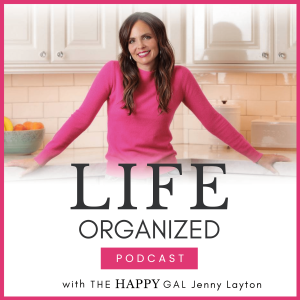
No matter the class, no matter the client, no matter the conversation, when the organizing conversation turns to paper, I see the same thing.
The inevitable eye roll. The overwhelm. The defeat.
Organizing paper creates a unique challenge because it requires us to organize both tangible and intangible clutter. Paper isn’t just an object - it is a container for a task. Which means we can’t stash it away and forget about it - and that’s where the problem comes in.
In episode 44 we will talk about how to extract the intangible action out of a piece of paper so we have peace of mind filing it away. Until we do, we’ll keep letting the papers stack up, because “out of sight, out of mind” feels like a very real threat. So we leave paper out where we can see it…only to discover that this tactic quickly gets out of hand. A pile of papers or sticky notes can’t remind us to do anything when it gets covered up by yet more paper. Iin fact, all the “noise” just shuts us down.
So in this episode I give you a place to start. The first step with paper is to pull the task out of it by adding it to your to do list, and manage the task from there. Then we can feel a lot more comfortable storing the paper in a filing cabinet somewhere.
And if you’re not quite comfortable or enchanted by the idea of a to do list, that’s where the Life Organized membership can help. Next month we are revolutionizing the way you manage a to do list, and you will find that with the right strategy, habits, and platform, your to do list can be like your own personal assistant, keeping you on track and helping you know what to do - and when to do it.
Then once it’s in your to do list, we are ready to actually put the paper somewhere. But it isn’t as easy as it seems, because…Where do you put it? How can we find it if we need it? And when do we toss it so we don’t have so much paper building up over time? That’s all covered in part 2 in episode 45.
Tools taught in this episode:- The To-Do List
- Life Organized Membership
More Episodes
 2023-10-25
2023-10-25
 2.0k
2.0k
 2023-09-20
2023-09-20
 1.2k
1.2k
 2023-09-13
2023-09-13
 788
788
 2023-09-06
2023-09-06
 908
908
 2023-08-30
2023-08-30
 928
928
 2023-08-23
2023-08-23
 995
995
 2023-08-16
2023-08-16
 739
739
 2023-08-09
2023-08-09
 774
774
 2023-08-02
2023-08-02
 812
812
 2023-07-26
2023-07-26
 729
729
 2023-07-05
2023-07-05
 561
561
 2023-06-28
2023-06-28
 585
585
 2023-06-21
2023-06-21
 612
612
 2023-06-14
2023-06-14
 625
625
 2023-06-07
2023-06-07
 637
637
 2023-05-31
2023-05-31
 704
704
 2023-05-24
2023-05-24
 752
752
 2023-05-13
2023-05-13
 623
623
Create your
podcast in
minutes
- Full-featured podcast site
- Unlimited storage and bandwidth
- Comprehensive podcast stats
- Distribute to Apple Podcasts, Spotify, and more
- Make money with your podcast
It is Free
- Privacy Policy
- Cookie Policy
- Terms of Use
- Consent Preferences
- Copyright © 2015-2024 Podbean.com





